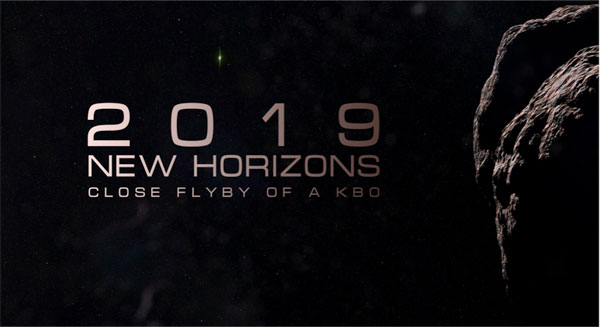"Ultima Thule," the next target for the New Horizons mission, is getting ever bigger within the spacecraft's sights. Alan Stern brings us the latest update on preparations for the New Year's Day flyby.
NASA’s New Horizons spacecraft will close in on the most distant object in the solar system ever to be explored on January 1, 2019. Our target is called 2014 MU69 (nicknamed Ultima Thule). At the time of closest approach, 5:33 UT (33 minutes past midnight on the U.S. East Coast), the spacecraft will fly within 3,500 kilometers of this world’s surface.

Roman Tkachenko
During the first two weeks of December, the New Horizons team used the spacecraft’s Long Range Reconnaissance Imager (LORRI) to take hundreds of images of Ultima Thule, enabling team scientists to search for evidence of satellites or dust rings that could pose a hazard to the spacecraft. After all, New Horizons will fly by Ultima at more than 32,000 mph. At that speed, an impact with even a millimeter-sized ice pellet could end the mission. LORRI consists of a 20-cm diameter Cassegrain telescope and CCD detector capable of reaching down to 21st magnitude (in the V band). Ten scientists comprising the New Horizons “hazard team” carefully scoured these images and found no hazards to flight. We are now cleared for the long-hoped-for, close-in flyby of Ultima Thule, where we’ll be passing just over three times closer than we came to Pluto. We should therefore obtain much sharper images and higher spectroscopic resolution than at Pluto!
Also in the past two weeks, our spacecraft navigation teams have been carefully tracking New Horizons using radio Doppler techniques that use quasars as reference points. We also used LORRI images to measure Ultima’s position with respect to the stars, comparing where Ultima actually is to where we calculated it would be. We then fired thrusters three times to correct the spacecraft’s course on October 3rd, December 2nd, and December 18th.

NASA / Johns Hopkins Applied Physics Laboratory / SwRI
The images we’ve been making with LORRI for hazard and navigation purposes also allow us to study Ultima’s brightness variations as it rotates. However, even taking into account the object’s known irregular shape, the light curve hasn’t revealed a clear rotation period yet . Perhaps we’re approaching along Ultima’s pole, so even as it spins, we wouldn’t see the object’s brightness change. Alternatively, because that’s somewhat unlikely, perhaps Ultima is surrounded by closely orbiting satellites or a dust cloud that mask its rotational light curve. Or perhaps something else altogether is going on. We will soon know, as we swoop past the object on December 31st and January 1st. High-resolution images of this world should reach Earth by January 1st, telling the tale.
Then, throughout January and the succeeding 19 months — until late 2020 — images, spectra, and other data types will flow to Earth every week, revealing many more details about Ultima. Our first batch of scientific reports will be at the 50th Lunar and Planetary Science Conference in March, and our first scientific papers will appear in the journal Science in late spring and summer.
But you don’t have to wait for those events to see for yourself. You can follow the flyby as it takes place on Twitter and other social media, on our project web site, and on NASA TV in real time.
New Horizons Links:
- NASA's New Horizons website
- New Horizons mission website
- NASA New Horizons on Twitter
- The PI’s “Inside View” on Twitter
- New Horizons on Facebook
- New Horizons E-News signup
Other ways to participate can be found here.
Ultima Thule will be the most distant world anyone has ever explored, and it is expected to be the most pristine sample of our system’s ancient era of planetary formation ever studied. An entire Decadal Survey of the U.S. National Academy directed this exploration. What will we find when we get there? We began this mission in 2001 with a proposal to NASA; in just a matter of days, we will find out.
This blog is part of a four-part series covering the Ultima Thule flyby. Click on the links below for the other installments:
Part One: New Horizons on Approach to the First Exploration of a Kuiper Belt Object
Part Two: Planning the New Horizons Exploration of Ultima Thule
 6
6









Comments
goodricke1
December 28, 2018 at 4:15 pm
'Oumuamua passed closer to the Earth than New Horizons will to Ultima Thule, relatively speaking. Makes you wonder...
You must be logged in to post a comment.
Alexander Vasenin
December 28, 2018 at 7:12 pm
Actually New Horizons will pass in just 3,500 km of Ultima Thule, while Oumuamua closest approach to Earth was only 24,180,000 km.
You must be logged in to post a comment.
TVR
December 29, 2018 at 5:21 am
Huh? What are you using to support this thesis?
You must be logged in to post a comment.
TVR
December 29, 2018 at 5:22 am
I'm replying to "goodricke1" ...
You must be logged in to post a comment.
Capbat
December 28, 2018 at 8:16 pm
Very good work, thanks.
Bat
You must be logged in to post a comment.
patrick-morton
December 31, 2018 at 3:40 pm
Congatulations sir !! wonderfull article. thank yyou.
You must be logged in to post a comment.
You must be logged in to post a comment.